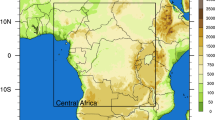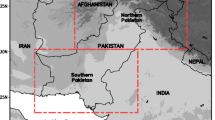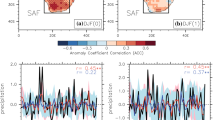Abstract
A 15 member ensemble of 20th century simulations using the ECHAM4–T42 atmospheric GCM is utilized to investigate the potential predictability of interannual variations of seasonal rainfall over Africa. Common boundary conditions are the global sea surface temperatures (SST) and sea ice extent. A canonical correlation analysis (CCA) between observed and ensemble mean ECHAM4 precipitation over Africa is applied in order to identify the most predictable anomaly patterns of precipitation and the related SST anomalies. The CCA is then used to formulate a re-calibration approach similar to model output statistics (MOS) and to derive precipitation forecasts over Africa. Predictand is the climate research unit (CRU) gridded precipitation over Africa. As predictor we use observed SST anomalies, ensemble mean precipitation over Africa and a combined vector of mean sea level pressure, streamfunction and velocity potential at 850 hPa. The different forecast approaches are compared. Most skill for African precipitation forecasts is provided by tropical Atlantic (Gulf of Guinea) SST anomalies which mainly affect rainfall over the Guinean coast and Sahel. The El Niño/Southern Oscillation (ENSO) influences southern and East Africa, however with a lower skill. Indian Ocean SST anomalies, partly independent from ENSO, have an impact particularly on East Africa. As suggested by the large agreement between the simulated and observed precipitation, the ECHAM4 rainfall provides a skillful predictor for CRU precipitation over Africa. However, MOS re-calibration is needed in order to provide skillful forecasts. Forecasts using MOS re-calibrated model precipitation are at least as skillful as forecast using dynamical variables from the model or instantaneous SST. In many cases, MOS re-calibrated precipitation forecasts provide more skill. However, differences are not systematic for all regions and seasons, and often small.























Similar content being viewed by others
References
Adejuwon JO, Odekunle TO (2004) Skill assessment of the existing capacity for extended-range weather forecasting in Nigeria. Int J Climatol 24:1249–1265
Barnett TP, Preisendorfer R (1987) Origins and levels of monthly and seasonal forecast skill for United States surface air temperatures determined by canonical correlation analysis. Mon Weather Rev 115:1825–1850
Barnston AG, Smith TM (1996) Specification and prediction of global surface temperature and precipitation from global SST using CCA. J Climate 9:2660–2697
Barnston AG, Thiaw W, Kumar V (1996) Long-lead forecasts of seasonal precipitation in Africa using CCA. Weather Forecast 11:506–520
Barnston AG, Mason SJ, Goddard L (2003) Multimodel ensembling in seasonal climate forecasting at IRI. Bull Am Meteorol Soc 84:1783–1796
Barnston AG, Kumar A, Goddard L, Hoerling MP (2005) Improving seasonal prediction practices through attribution of climate variability. Bull Am Meteorol Soc 86:59–72
Barreiro M, Chang P, Ji L, Saravanan R, Giannini A (2004) Dynamical elements of predicting boreal spring Tropical Atlantic sea-surface temperatures. Dyn Atmos Oceans 31:61–85. DOI 10.1016/j.dynatmoce.2004.10.013
Bartman AG, Landman WA, Rautenbach CJDW (2004) Recalibration of general circulation model output to austral summer rainfall over southern Africa. Int J Climatol 23:1407–1419
Bergonzini L, Richard Y, Petit L, Camberlin P (2004) Zonal circulations over the Indian and Pacific Oceans and the level of lakes Victoria and Tanganyika. Int J Climatol 24:1613–1624
Black E, Slingo J, Sperber KR (2003) An observatonal study of the relationship between excessively strong short rains in coastal East Africa and Indian Ocean SST. Mon Weather Rev 131:74–94
Bray D, von Storch H (1999) Climate science. An empirical example of postnormal science. Bull Am Meteorol Soc 80:439–456
Bretherton C, Smith C, Wallace JM (1992) An intercomparison of methods for finding coupled patterns in climate data. J Clim 5:541–560
Camberlin P, Janicot S, Poccard I (2001) Seasonality and atmospheric dynamics of the teleconnection between African rainfall and tropical sea-surface temperature: Atlantic vs. ENSO. Int J Climatol 21:973–1004
Cane MA, Eschel G, Buckland R (1994) Forecasting Zimbabwean Maize Yield using eastern equatorial Pacific sea surface temerature. Nature 370:204–205
Chatelain C, Gautier L, Spichiger R (1996) A recent history of forest fragmentation in southwestern Ivory Coast. Biodivers Conserv 5:7–53
Clark CO, Webster PJ, Cole JE (2003) Interdecadal variability of the relationship between the Indian Ocean zonal model and East Africa costal rainfall anomalies. J Clim 16:548–554
Crowley TJ (2000) Causes of climate change over the past 1000 years. Science 289:270–277
Feddersen H, Navarra A, Ward MN (1999) Reduction of model systematic error by statistical correction for dynamical seasonal predictions. J Clim 12:1974–1989
Fontaine B, Philippon N, Camberlin P (1999) Prediction of seasonal rainfall forecasting in the Sahel based upon region April–May moist static energy content. Geophys Res Lett 26:2041–2044
Friederichs P, Frankignoul C (2003) Potential seasonal predictability of the observed Euro-Atlantic atmospheric variability using SST forced ECHAM4–T42 simulations. Q J R Meteorol Soc 129:2879–2896
Friederichs P, Hense A (2003) Statistical inference in canonical correlation analysis exemplified by the influence of Northern Atlantic SST on European-Atlantic climate variability. J Clim 16:522–534
Giannini A, Saravanan R, Chang P (2003) Oceanic forcing of Sahel rainfall on interannual to interdecadal time scales. Science 302:1027–1030
Gill AE (1980) Some simple solutions for heat-induced tropical circulation. Q J R Meteorol Soc 106:447–462
Glahn HR, Lowry DA (1972) The use of model output statistics (MOS) in objective weather forecasting. J Appl Meteorol 11:1203–1211
Goddard L, Graham NE (1999) Importance of the Indian Ocean for simulating rainfall anomalies over eastern and southern Africa. J Geophys Res 104:19099–19116
Goddard L, Mason SJ (2002) Sensitivity of seasonal climate forecasts to persisted SST anomalies. Clim Dyn 19:619–631
Goddard L, Mason SJ, Zebiak SE, Ropelewski CF, Basher R, Cane M (2001) Current approaches to climate prediction. Int J Climatol 21:1111–1152
Goddard L, Barnston AG, Mason SJ (2003) Evaluation of the IRI’s ‘Net Assessment’ seasonal climate forecasts 1997–2001. Bull Am Meteorol Soc 84:1761–1781
Goswami SSBN, Vinayachandran PN, Yamagata T (1999) A dipole mode in the Indian Ocean. Nature 401:360–363
Haarsma R, Selten F, Weber S, Kliphuis M (2005) Sahel rainfall variability and response to greenhouse warming. Geophys Res Lett 32:L17702. DOI 10.1029/2005GL023232
Hastenrath S, Polzin D, Camberlin P (2004) Exploring the predictability of the Short Rains at the coast of East Africa. Int J Climatol 24:1333–1343
Janicot S, Trzaska S, Poccard I (2001) Summer Sahel-ENSO teleconnection and decadal time scale SST variations. Clim Dyn 18:303–320
Jenkins GM, Watts DG (1968) Spectral analysis and its applications. San Francisco Holden-Day, p 525
Landman WA, Goddard L (2002) Statistical recalibration of GCM forecasts over southern Africa using model output statistics. J Clim 15:2038–2055
Latif M, Dommenget D, Dima M, Grötzner A (1999) The role of Indian Ocean sea surface temperature in forcing East African rainfall anomalies during December–January 1997/1998. J Clim 12:3497–3504
Le Barbé L, Lebel T, Tapsoba D (2002) Rainfall variability in West Africa during the years 1950–90. J Clim 15:187–202
Mason SJ, Goddard L, Graham NE, Yulaeva E, Sun L, Arkin PA (1999) The IRI seasonal climate prediction system and the 1997/1998 El Niño event. Bull Am Meteorol Soc 80:1853–1873
Matsuno T (1966) Quasi-geostrophic motions in the equatorial area. J Meteorol Soc Jpn 44:25–43
Michaelsen J (1987) Cross-validation in statistical climate forecast models. J Clim Appl Meteorol 26:1589–1600
Mitchell TD, Carter TR, Jones PD, Hulme M, New M (2004) A comprehensive set of high-resolution grids of monthly climate for Europe and the globe: the observed record (1901–2000) and 16 scenarios (2001–2100). Tyndall Centre Working Paper 55, Tyndall Centre for Climate Change Research, University of East Anglia, Norwich, UK, p 30
Mo K, Thiaw WM (2002) Ensemble canonical correlation prediction of precipitation over the Sahel. Geophys Res Lett 29:1570. DOI 10.1029/2002GL015075
New M, Hulme M, Jones P (2000) Representing twentieth-century space–time climate variability. Part II. Development of 1901–96 monthly grids of terrestrial surface climate. J Clim 13:2217–2238
Nicholson SE, Kim J (1997) The relationship of the El Niño-Southern Oscillation to African rainfall. Int J Climatol 17:117–135
Nicholson SE, Selato JC (2000) The influence of La Niña on African rainfall. Int J Climatol 20:1761–1776
Paeth H, Friederichs P (2004) Seasonality and time scales in the relationship between global SST and African rainfall. Clim Dyn 22:815–837
Paeth H, Hense A (2003) Seasonal forecast of sub-Sahelian rainfall using cross validated model output statistics. Meteorol Zeitschrift 12:157–173
Paeth H, Hense A (2004) SST versus climate change signals in West African rainfall: 20th century variations and future projections. Clim Change 65:179–208
Paeth H, Stuck J (2004) The West African dipole in rainfall and its forcing mechanisms in global and regional climate models. Mausam 55:561–582
Palmer TN, Brankovi C, Viterbo P, Miller M (1992) Modeling interannual variations of summer monsoons. J Clim 5:399–417
Palmer TN, Alessandri A, Andersen U, Cantelaube P, Davey M, Déqué M, Díaz E, Doblas-Reyes FJ, Feddersen H, Graham R, Gualdi S, Guérémy J-F, Hagedorn R, Hoshen M, Keenlyside N, Latif M, Lazar A, Maisonnave E, Marletto V, Morse AP, Orfila B, Rogel P, Terres J-M, Thomson MC (2004) Development of a European multi-model ensemble system for seasonal to inter-annual prediction (DEMETER). Bull Am Meteorol Soc 85:853–872
Poccard I, Janicot S, Camberlin P (2000) Comparison of rainfall structures between NCEP/NCAR reanalyses and observed data over tropical Africa. Clim Dyn 16:897–915
Rayner NA, Horton EB, Parker DE, Folland CK, Hackett RB (1996) Version 2.2 of the global sea-ice and sea surface temperature data set, 1903–1994. Climate Research Technical Note 74, Hadley Centre for Climate Prediction and Research, Meteorological Office, Bracknell, UK
Roeckner E, Arpe K, Bengtsson L, Christoph M, Claussen M, Duemenil L, Esch M, Giorgetta M, Schlese U, Schulzweida U (1996) The atmospheric general circulation model ECHAM-4: model description and simulation of present day climate. Technical Report 218, Max Planck Institute for Meteorology, Hamburg, p 90
Ropelewsky CF, Halpert MS (1998) Precipitation patterns associated with the high index phase of the Southern Oscillation. J Clim 2:268–284
Seleshi Y, Zanke U (2004) Recent changes in rainfall and rainy days in Ethiopia. Int J Climatol 24:973–983
Sutton RT, Jewson SP, Rowell DP (2000) The elements of climate variability in the tropical Atlantic region. J Clim 13:3261–3284
Thiaw WM, Barnston AG, Kumar V (1999) Predictions of African rainfall on the seasonal timescale. J Geophys Res 104(D24):31589–31597
Vialard J, Vitart F, Balmaseda MA, Stockdale TN, Anderson DLT (2005) An ensemble generation method for seasonal forecasting with an ocean–atmosphere coupled model. Mon Weather Rev 133:441–453
Vizy EK, Cook KH (2001) Mechanisms by which Gulf of Guinea and Eastern North Atlantic sea surface temperature anomalies can influence African rainfall. J Clim 14:795–821
Vizy EK, Cook KH (2003) Connections between the summer east African and Indian rainfall regimes. J Geophys Res 108(D16):4510. DOI 10.1029/2003JD003452
Ward MN (1998) Diagnosis and short-lead time prediction of summer rainfall in tropical North Africa at interannual and multi-decadal timescales. J Clim 11:3167–3191
Washington R, Preston A, Todd MC (2003) The role of Indian and Pacific Ocean SSTs in African rainfall variability. Bull Am Meteorol Soc 84:899–900
Zorita E, von Storch H, González-Rouco F, Cubasch U, Luterbacher J, Legutke S, Fischer-Bruns I, Schlese U (2004) Climate evolution in the last five centuries simulated by an atmosphere ocean model: global temperatures, the North Atlantic Oscillation and the Late Maunder Minimum. Meteorol Zeitschrift 13:271–289
Zwiers FW, Kharin V, von Storch H (1996) Interannual variability and predictability in an ensemble of AMIP climate simulations constructed with the CCC GCM2. Clim Dyn 12:825–847
Author information
Authors and Affiliations
Corresponding author
Appendix
Appendix
Over many African regions the CRU gridded data are based only on very few station data. Data sparce areas with almost no observations are the Sahara and central Africa (e.g., large parts of the DR Congo). In order to assess the sensitivity of our results to inhomogeneous data coverage, we repeated the MOS re-calibration forecast for the first and second half of the century, respectively. Figure 24 shows the correlation coefficients between the MOS re-calibrated ECHAM4 forecast and the CRU precipitation for the period from 1903 to 1952 (left column), and from 1953–2002 (middle column). For both periods, the MOS re-calibration was derived from the whole available period of data, but the forecast was performed only for the period from 1903 to 1952 or 1953 to 2002, respectively. The right column panels in Fig. 24 show the correlation coefficients for a forecast where both, the training as well as the forecast include only data from 1953 to 2002. The 95% level of significant correlations (N = 50) is now 0.28. However, for reason of comparability we kept the scale as in Fig. 12.
First of all, potential predictability for the JFM and AMJ season seems stronger during the first compared to the second half of the century (compare left and middle column in Fig. 24). Data are very sparce in that region, with almost no station data before the 1930s. Thus, this strong signal of potential predictability might well be an artifact of the sparce data. During the JAS and OND seasons predictability is larger during the second half of the century. Besides the data quality, this might also result from a stronger ENSO activity during the second half of the century. This follows also from Fig. 25, where the distributions of the correlation coefficients is represented.
Distribution of the correlation coefficients over Africa from Fig. 24. The dotted dashed line represents the forecast for 1903–1952, the solid line the forecast for 1953–2002, both using all data during the training, the dashed line represents the forecast without using data prior to 1953
Excluding the first half of the century from the training process tends to slightly degrade the forecast (Fig. 24, right column). When comparing the distributions of the correlation coefficients (Fig. 25), the tendency to produce more negative and weaker positive correlations using the short-training period (dashed line) is particularly strong for OND, but holds for all seasons including those not shown here. Thus, no evidence is found that including the data prior to the 1950 degrades the forecast.
Rights and permissions
About this article
Cite this article
Friederichs, P., Paeth, H. Seasonal prediction of African precipitation with ECHAM4–T42 ensemble simulations using a multivariate MOS re-calibration scheme. Clim Dyn 27, 761–786 (2006). https://doi.org/10.1007/s00382-006-0154-4
Received:
Accepted:
Published:
Issue Date:
DOI: https://doi.org/10.1007/s00382-006-0154-4






